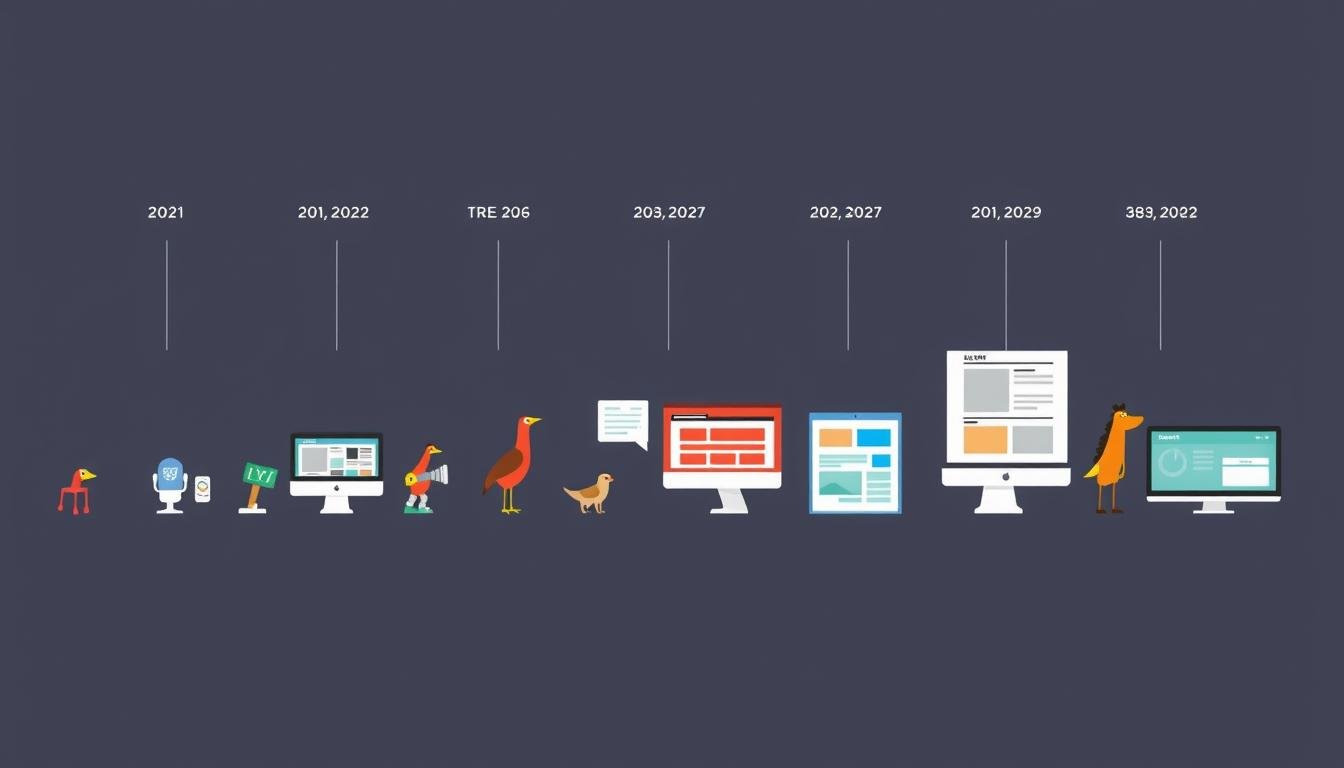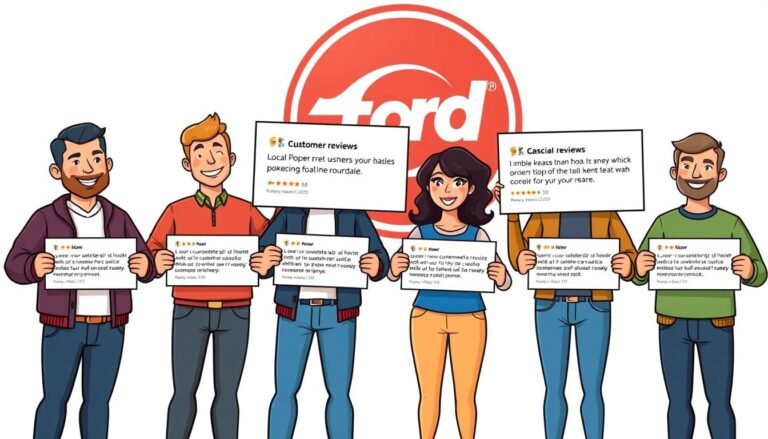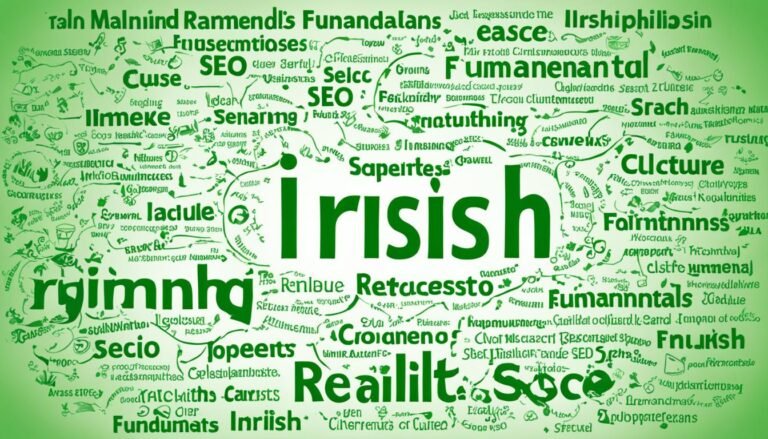Comprehensive Guide to Web Design Trends
Did you know that about 60% of web traffic now comes from mobile devices? This shows how crucial modern web design is today. As technology grows, so does the need for effective websites. It’s vital for businesses to keep up with web design trends.
Visitors today want smooth experiences on all devices. That’s why knowing and using these trends is key. By doing so, businesses can improve user engagement and trust through good design. Tools like HubSpot’s drag-and-drop builder make adding new design features easy and quick.
The world of web design is always changing, from flat design to microinteractions. By keeping up with the latest trends, experts can make sites that grab users and offer great experiences. Let’s explore the exciting world of modern web design together.
Key Takeaways
- Responsive design is essential for improving user experience across devices.
- Utilizing flat design promotes simplicity and ease of navigation.
- Microinteractions enhance user engagement by providing feedback.
- Bold typography can capture attention and highlight important information.
- Custom illustrations and animations foster creativity and storytelling.
Understanding the Importance of Web Design Trends
Web design trends play a big role in how users feel about a website and trust the brand. Keeping up with these trends makes websites more engaging and satisfying for users. Modern design aims to create a site that looks good and is easy to use.
Enhancing User Experience Through Modern Design
Modern design makes it simple for users to find what they need. Key features that improve user experience include:
- Bold, oversized lettering: This style helps users quickly scan pages and boosts conversion rates.
- Asymmetrical grid design: It’s user-friendly and makes it easy to spot important parts of a page.
- Hidden navigation systems: This minimalist approach makes for a smooth user experience.
- Fast loading times: Sites that load quickly are more likely to keep users.
Building Trust with Visual Appeal
Looks matter when it comes to building trust with visitors. Good graphics and a well-designed layout make a site more credible. Key elements are:
- High-quality images: These make a strong first impression.
- Effective typography: It makes reading easy and helps guide users through content.
- Consistent branding: It strengthens a brand’s identity through visuals.
- Use of videos: Videos engage users well without slowing down the site.
Studies show that over 75% of users judge a company’s trustworthiness by its website design. This shows how important visuals are in keeping user trust.
Key Web Design Trends to Watch in 2023
As we move into 2023, new web design trends are popping up. They meet the changing needs and likes of users. It’s key to use these trends to make online spaces that draw in and keep visitors. This year, we’re seeing big moves towards designs that adapt well to different devices, simple yet striking styles, and adding fun elements to keep users hooked.
Responsive Design Adaptations
Responsive design is still a big deal in web trends. It makes sure websites work well on phones, tablets, and computers. Designers use flexible grids and images to make sure sites are easy to use everywhere. With more people using mobiles, making sites that adjust to any screen size is a must.
Minimalist vs. Ultra-Minimalist Approaches
Minimalist design is still in, focusing on simplicity and cutting out clutter. Ultra-minimalist takes it further by removing almost all distractions. This makes sites load faster and users happier, leading to a better experience overall.
Gamification Elements for Engagement
Gamification is getting more popular to keep users interested and engaged. By adding things like leaderboards and rewards, designers make sites more fun to visit. This approach makes users want to come back, which helps keep them coming back for more.
Comprehensive Guide to Web Design Trends
The web design world is always changing, bringing new features that catch users’ eyes and make their experience better. Interactive design elements are key to boosting engagement. Designers now focus on making sites more dynamic and engaging while keeping them visually appealing.
Innovative Features Shaping Future Designs
3D design is becoming more popular in websites, adding depth that was missing before. Kinetic typography makes text come alive, turning static words into moving stories. Structured typography is also on the rise, making websites with lots of text clearer and more organized.
Cinemagraphs add a touch of movement, catching the eye without being too much. Geometric shapes and patterns are becoming more common, making sites more engaging and visually appealing.
Interactive Web Design Techniques
Drag interactions let users control how they move through a site. New navigation patterns are shaking up traditional ways, making sites more engaging. Mixing text alignments in new ways catches the eye and adds visual interest.
Animated illustrations are becoming more common, letting users interact with content in a fun way. These new features and interactive designs make the user experience better and help tell stories.
Microinteractions Enhancing User Engagement
Microinteractions, like button hovers and loading indicators, give users real-time feedback. They make the site feel more responsive and supportive. Designers use layered elements to add depth and texture, making sites more immersive.
This focus on details means we can expect more sites to focus on user experience in 2024. It’s all about making users happy and keeping them engaged.
| Design Trend | Description |
|---|---|
| 3D Design | Enhances depth and visual appeal. |
| Kinetic Typography | Engages users with dynamic text. |
| Cinemagraphs | Provides subtle movement for interest. |
| Drag Interactions | Offers users control over navigation. |
| Layered Elements | Adds texture and depth to designs. |
| Animated Illustrations | Increases interactivity of content. |
Your Essential Toolkit for Modern Web Design
Having the right tools is key for modern web design. The right tools boost both the look and function of a website. Using responsive design, bold fonts, and custom illustrations makes websites not just look good but also work well for users.
Tools for Creating Responsive Sites
Responsive web design is a must in 2024, with more devices out there. Designers often use frameworks like Bootstrap and Foundation for easy changes on different screens. Tools like Adobe XD and Figma help make layouts that work well on any device, keeping the site engaging.
Incorporating Bold Typography
Bold fonts are big for making text stand out. With Google Fonts and Adobe Fonts, designers can pick from many fonts to get their message across. This makes reading easier and highlights important info, grabbing user attention and making their visit better.
Utilizing Custom Illustrations
Custom illustrations add a special touch to a website. With Adobe Illustrator and Procreate, designers can make unique images that match their brand. These illustrations can touch feelings and tell stories, blending well with other design parts for a unified look.
| Tool | Purpose | Key Features |
|---|---|---|
| Bootstrap | Responsive Framework | Grid system, pre-styled components |
| Adobe XD | Design Prototyping | Vector design, collaboration tools |
| Google Fonts | Typography | Wide selection, easy integration |
| Procreate | Custom Illustrations | Intuitive interface, extensive brush options |
| Figma | Collaborative Design | Live editing, cloud-based storage |
Conclusion
The world of web design is always changing. It’s key to keep up with the newest trends. CSS changed design in the late 1990s, leading to responsive design. This is now crucial with more people using mobile devices.
Websites that don’t work well on mobile devices lose out on visitors. This shows why a mobile-first approach is important. It helps with user engagement and satisfaction.
Modern design uses minimalism, bold fonts, and custom illustrations to grab attention. Accessibility is also key, making sure everyone can use your site. New tech like AI, AR, and VR will shape web design’s future. Using these innovations can help businesses stay ahead.
Good web design is vital for attracting visitors and improving search engine rankings. As we move into 2024 and beyond, companies should focus on sustainability, new tools, and user experience. Staying up-to-date with design trends helps web designers and businesses succeed in a fast-changing world.
Source Links
- A Comprehensive Guide to Website Design Trends in 2023
- Comprehensive Guide To Web Design | 2024 – 7boats
- Web Design Trends and Why They Work
- Understanding Web Design: A Comprehensive Guide
- A Comprehensive Guide to Web Design Trends through User Research
- The Top Web Design Trends to Watch in 2023 – Devitus Digital
- Top Web Design Trends 2023 – Designmodo
- 15 Web Design Trends You Absolutely Need to Know in 2023
- The 29 Dominating Web Design Trends for 2024
- The Top 10 Web Design Trends in 2024 • Bryt Designs
- Top Web Design Trends 2024 – Designmodo
- 2024 Web Design Trends To Modernize and Enhance Your Website
- 6 Modern Web Design Trends in 2024 to Inspire your Design
- A guide to modern web design principles + 11 latest trends
- The Past, Present, and Future of Web Design: A Comprehensive Guide – Footprint Digital
- Introduction to Web Design Trends in 2024








